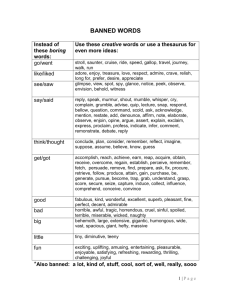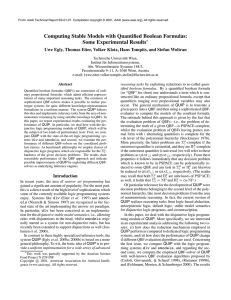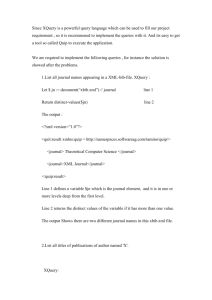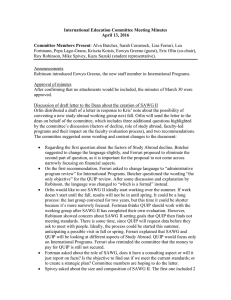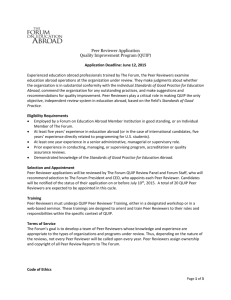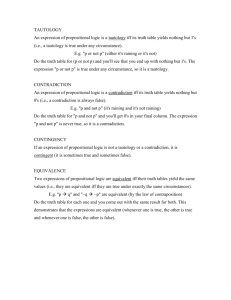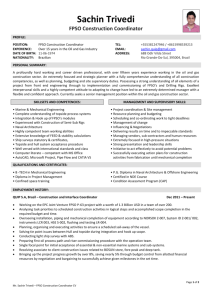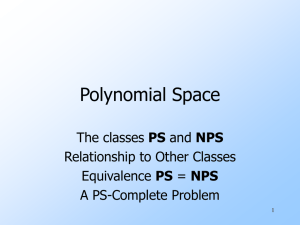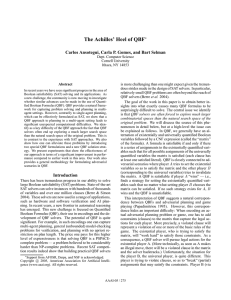Solving Advanced Reasoning Tasks using Quantified Boolean Formulas
advertisement
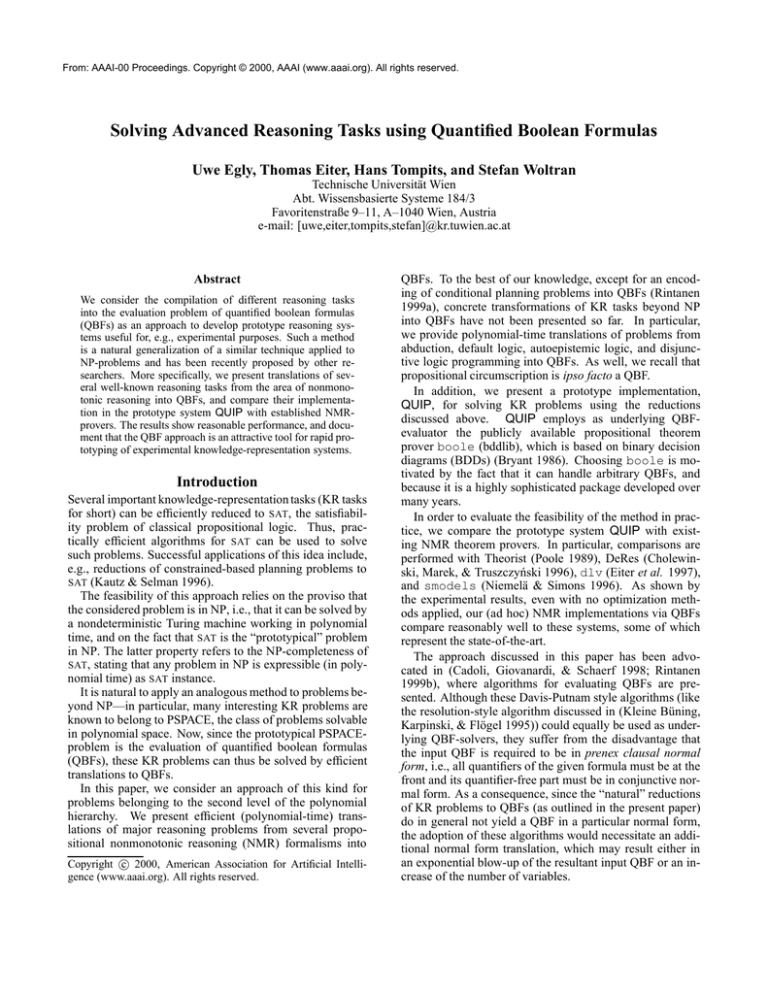
From: AAAI-00 Proceedings. Copyright © 2000, AAAI (www.aaai.org). All rights reserved.
Solving Advanced Reasoning Tasks using Quantified Boolean Formulas
Uwe Egly, Thomas Eiter, Hans Tompits, and Stefan Woltran
Technische Universität Wien
Abt. Wissensbasierte Systeme 184/3
Favoritenstraße 9–11, A–1040 Wien, Austria
e-mail: [uwe,eiter,tompits,stefan]@kr.tuwien.ac.at
Abstract
We consider the compilation of different reasoning tasks
into the evaluation problem of quantified boolean formulas
(QBFs) as an approach to develop prototype reasoning systems useful for, e.g., experimental purposes. Such a method
is a natural generalization of a similar technique applied to
NP-problems and has been recently proposed by other researchers. More specifically, we present translations of several well-known reasoning tasks from the area of nonmonotonic reasoning into QBFs, and compare their implementation in the prototype system QUIP with established NMRprovers. The results show reasonable performance, and document that the QBF approach is an attractive tool for rapid prototyping of experimental knowledge-representation systems.
Introduction
Several important knowledge-representation tasks (KR tasks
for short) can be efficiently reduced to SAT, the satisfiability problem of classical propositional logic. Thus, practically efficient algorithms for SAT can be used to solve
such problems. Successful applications of this idea include,
e.g., reductions of constrained-based planning problems to
SAT (Kautz & Selman 1996).
The feasibility of this approach relies on the proviso that
the considered problem is in NP, i.e., that it can be solved by
a nondeterministic Turing machine working in polynomial
time, and on the fact that SAT is the “prototypical” problem
in NP. The latter property refers to the NP-completeness of
SAT, stating that any problem in NP is expressible (in polynomial time) as SAT instance.
It is natural to apply an analogous method to problems beyond NP—in particular, many interesting KR problems are
known to belong to PSPACE, the class of problems solvable
in polynomial space. Now, since the prototypical PSPACEproblem is the evaluation of quantified boolean formulas
(QBFs), these KR problems can thus be solved by efficient
translations to QBFs.
In this paper, we consider an approach of this kind for
problems belonging to the second level of the polynomial
hierarchy. We present efficient (polynomial-time) translations of major reasoning problems from several propositional nonmonotonic reasoning (NMR) formalisms into
c 2000, American Association for Artificial IntelliCopyright gence (www.aaai.org). All rights reserved.
QBFs. To the best of our knowledge, except for an encoding of conditional planning problems into QBFs (Rintanen
1999a), concrete transformations of KR tasks beyond NP
into QBFs have not been presented so far. In particular,
we provide polynomial-time translations of problems from
abduction, default logic, autoepistemic logic, and disjunctive logic programming into QBFs. As well, we recall that
propositional circumscription is ipso facto a QBF.
In addition, we present a prototype implementation,
QUIP, for solving KR problems using the reductions
discussed above. QUIP employs as underlying QBFevaluator the publicly available propositional theorem
prover boole (bddlib), which is based on binary decision
diagrams (BDDs) (Bryant 1986). Choosing boole is motivated by the fact that it can handle arbitrary QBFs, and
because it is a highly sophisticated package developed over
many years.
In order to evaluate the feasibility of the method in practice, we compare the prototype system QUIP with existing NMR theorem provers. In particular, comparisons are
performed with Theorist (Poole 1989), DeRes (Cholewinski, Marek, & Truszczyński 1996), dlv (Eiter et al. 1997),
and smodels (Niemelä & Simons 1996). As shown by
the experimental results, even with no optimization methods applied, our (ad hoc) NMR implementations via QBFs
compare reasonably well to these systems, some of which
represent the state-of-the-art.
The approach discussed in this paper has been advocated in (Cadoli, Giovanardi, & Schaerf 1998; Rintanen
1999b), where algorithms for evaluating QBFs are presented. Although these Davis-Putnam style algorithms (like
the resolution-style algorithm discussed in (Kleine Büning,
Karpinski, & Flögel 1995)) could equally be used as underlying QBF-solvers, they suffer from the disadvantage that
the input QBF is required to be in prenex clausal normal
form, i.e., all quantifiers of the given formula must be at the
front and its quantifier-free part must be in conjunctive normal form. As a consequence, since the “natural” reductions
of KR problems to QBFs (as outlined in the present paper)
do in general not yield a QBF in a particular normal form,
the adoption of these algorithms would necessitate an additional normal form translation, which may result either in
an exponential blow-up of the resultant input QBF or an increase of the number of variables.
Translations into QBFs
In this section, we discuss how some well-known logical formalisms in AI can be mapped to QBFs in polynomial time.
We focus here on major NMR formalisms. For space reasons, the exposition is necessarily succinct.
All formalisms are propositional. We assume a finite set
of propositional variables V and constants 1, 0, denoting
truth and falsity, respectively. The set L of propositional
formulas is defined in the usual way, using the sentential
connectives ¬, ∧, ∨, →, and ↔. Formulas will be denoted
by Greek lower-case letters. A theory, T , is a finite set of
formulas.VIn general, a theory T will be identified with the
formula φ∈T φ.
Quantified boolean formulas (QBFs) generalize ordinary
propositional formulas by the admission of quantifications
over propositional variables (QBFs are denoted by Greek
upper-case letters).
The truth value of a QBF Φ without free variables (i.e.,
where all variables in Φ are within the scope of a quantifier)
is recursively defined as follows:
• if Φ = 1, then Φ is true;
• if Φ = 0, then Φ is false;
• if Φ = ¬Ψ, then Φ is true iff Ψ is false;
• if Φ = Φ1 ∨ Φ2 , then Φ is true iff either Φ1 or Φ2 is true.
• If Φ = ∃x Ψ, then Φ is true iff Ψ[x/0] ∨ Ψ[x/1] is true.
(Here, Ψ[v/c] denotes the substitution of c for v in Ψ.) The
cases of the remaining operators follow from the given ones
in the usual way.
Let S = {φ1 , . . . , φn } and T = {ψV
1 , . . . , ψn } be sets of
formulas. Then, S ≤ T abbreviates ni=1 (φi → ψi ), and
S < T is a shorthand for (S ≤ T ) ∧ ¬(T ≤ S). Furthermore, for a set P = {p1 , . . . , pn } of propositional variables
and a quantifier Q ∈ {∀, ∃}, we let QP φ stand for the formula Qp1 Qp2 · · · Qpn φ.
Abduction. Classical abduction from a theory T on V
may be defined as follows (Selman & Levesque 1990;
Poole 1989). Let H ⊆ V be a set of hypotheses, and let
p ∈ V be a distinguished atom. A subset E ⊆ H is an
abductive explanation for p from T and H, if
(i) T ∪ E is consistent, and
(ii) T ∪ E |= p, i.e., T ∪ E logically implies p.
An explanation E is minimal, if no proper subset E 0 ⊂ E is
an abductive explanation.
Assume that H = {h1 , . . . , hm }, and let G =
{g1 , . . . , gm } be a set of new propositional variables. The
following QBF Tabd (H, p, T ) expresses whether p has some
abductive explanation (by monotonicity of classical logic,
equivalently a minimal abductive explanation):
h i
∃G ∃V T ∧ (G ≤ H) ∧ ∀V (T ∧ (G ≤ H)) → p .
Intuitively, G guesses an explanation (determined by those
gi which are true), and the two conjuncts in the scope of ∃G
express conditions (i) and (ii), respectively.
The relevance problem is deciding whether a given hypothesis h belongs to some abductive explanation. This is
rel
expressed by the following QBF Tabd
(H, p, T, h):
h i
∃G ∃V T ∧(G ≤ H)∧h ∧∀V (T ∧(G ≤ H)∧h) → p .
For minimal abductive explanations, the relevance problem
mrel
(H, p, T, h) which results from
is expressed by a QBF Tabd
rel
Tabd (H, p, T, h) by adding within the scope of ∃G a conjunct for the minimality check:
m h
i
^
gi → ∃V T ∧ (G \ {gi } ≤ H \ {hi }) ∧ ¬hi ∧ ¬p .
i=1
It encodes (in terms of the auxiliary variable set G) the wellknown property that a set E ⊆ H is minimal iff E \ {e} is
not an explanation, for any e ∈ E, i.e., T ∪ (E \ {e}) ∪ {¬p}
is satisfiable, and where e is false.
rel
(H, p, T, h), and
Theorem 1 The QBFs Tabd (H, p, T ), Tabd
mrel
Tabd (H, p, T, h) evaluate to true iff the answer of the corresponding abduction task is “yes”.
Autoepistemic logic. The language of Moore’s autoepistemic logic (Moore 1985) contains the modal operator L,
where Lφ intuitively means that φ is believed. By LL we
denote the language L extended by L. In what follows, formulas Lφ are viewed as propositional variables, which are
called modal atoms.
A stable expansion of an autoepistemic theory T ⊆ LL is
a set of formulas E ⊆ LL such that
E = Cn(T ∪ {Lφ | φ ∈ E} ∪ {¬Lφ | φ ∈ LL \ E}),
where Cn(·) is the classical consequence operator with respect to the extended language LL .
The existence of a stable expansion can be expressed as
follows (Niemelä 1992). Let T ⊆ LL be an autoepistemic
theory, M be the set of all modal atoms occurring in T , and
V be the set of ordinary (non-modal) atoms in T . We say
that Λ ⊆ M ∪ {¬φ | φ ∈ M } is T -full iff, for all Lφ ∈ M ,
it holds that (i) T ∪ Λ |= φ iff Lφ ∈ Λ, and (ii) T ∪ Λ 6|= φ
iff ¬Lφ ∈ Λ.
Proposition 1 (Niemelä 1992) T ⊆ LL has a stable expansion iff there exists a T -full set.
For T , M , and V as above, this condition is easily translated
into the following QBF Tael (T ):
h V
∃M ∀V T → Lφ∈M (Lφ → φ) ∧
i
V
.
Lφ∈M ¬Lφ → ∃V (T ∧ ¬φ)
Theorem 2 A finite autoepistemic theory T ⊆ LL has a
stable expansion iff Tael (T ) evaluates to true.
Default Logic. A default theory is a pair T = (W, ∆),
where W ⊆ L is a set of formulae and ∆ is a set of defaults
of the form α γ: β .1 Intuitively, the default is applied (γ is
1
For simplicity, we omit multiple justifications here. Our QBF
translations can be easily extended to the more general form of
defaults.
concluded) if α is provable and the justification β can be
consistently assumed. T is said to be finite iff W is finite.
The semantics of T = (W, ∆) is defined in terms of extensions (Reiter 1980). Following (Marek & Truszczyński
1993), extensions can be characterised thus. For any S ⊆ L,
/ S}.
let ∆(S) be the monotonic rules { αγ | α γ: β ∈ ∆, ¬β ∈
Then, E ⊆ L is an extension of T iff E = Cn∆(E) (W ),
where Cn∆(E) (W ) is the set of all formulae derivable from
W using classical logic together with the rules from ∆(E).
Adopting this characterization, we next express the existence of an extension of a finite default theory (W, ∆) in
terms of a QBF.
Suppose ∆ = {δi = αiγ:i βi | 1 ≤ i ≤ n}. Let
D = {d1 , . . . , dn } and D0 = {d01 , . . . , d0n } be sets of new
propositional variables. Intuitively, di is true if δi is selected
into ∆(E), and d0i is true if δi fires in the construction of E,
i.e., if γi ∈ Cn∆(E) (T ). Then, the following QBF expresses
existence of an extension:
Tdl (T ) = ∃D0 ∃D((D0 ≤ D) ∧ Φ1 ∧ Φ2 ∧ Φ3 ∧ Φ4 ),
where Cn(W ∪ {γi | d0i is true }) is the guess for the extension E and Φ1 , . . . , Φ4 express the following tests (G denotes the set {γ1 , . . . , γn }):
• Φ1 tests whether the justification βi of each default δi in
the guessed set ∆(E) is consistent with the guess for E:
i
Vn h
Φ1 = i=1 di → ∃V βi ∧ W ∧ (D0 ≤ G) .
• Φ2 tests whether no applicable default in ∆(E) is missing
with respect to the guessed D0 ; i.e., for every δi such that
di is true but d0i is false, the set E ∪ {¬αi } is satisfiable:
i
Vn h
Φ2 = i=1 (di ∧ ¬d0i ) → ∃V ¬αi ∧ W ∧ (D0 ≤ G) .
/ ∆(E), its justifica• Φ3 tests whether for each default δi ∈
tion βi is inconsistent with E, i.e., ¬βi is derivable:
i
Vn h
Φ3 = i=1 ¬di → ∀V (W ∧ (D0 ≤ G)) → ¬βi .
• Φ4 tests whether all defaults in ∆(E) assumed to be applied (d0i is true) are actually applied (i.e., Cn∆(E) (W ) |=
{γi | d0i is true }). This amounts to checking whether
Vn
0
∆(E)
(W ), i.e., whether (D0 ≤
i=1 (di → γi ) ∈ Cn
G) ∈ Cn∆(E) (W ). Applying a result shown in (Gottlob 1995), φ ∈
/ Cn∆(E) (W ) iff there exists a subset
C ⊆ G = {γ1 , . . . , γn } such that (i) W ∪C ∪{¬φ} is sat/ C, the set W ∪ C ∪ {¬αi }
isfiable, and (ii) for each γi ∈
is satisfiable. Using the set C = {c1 , . . . , cn } of new variables, Φ4 is as follows:
n
∀C C ≤ D →
h
∀V ¬ W ∧ ¬(D0 ≤ G) ∧ (C ≤ G) ∨
n _
io
.
di ∧ ¬ci ∧ ∀V ¬ W ∧ ¬αi ∧ (C ≤ G)
i=1
Theorem 3 A finite default theory T = (W, ∆) has an extension iff Tdl (T ) evaluates to true.
An alternative (and more succinct) translation of default
logic into QBFs is possible using Niemelä’s characterization
of extensions in terms of full sets (Niemelä 1995). To this
end, for a set ∆ of defaults and a set S of formulas, define
α:β
j(∆) = {β | α γ: β ∈ ∆} and ∆p (S) = { α
∈
γ |
γ
∆, β ∈ S}.
Rephrasing a definition in (Niemelä 1995), a subset Λ ⊆
j(∆) is a full set for (W, ∆) iff every β ∈ j(∆) satisfies the
following condition: β ∈ Λ iff ¬β ∈
/ Cn∆p (Λ) (W ).
Proposition 2 (Niemelä 1995) There is a one-to-one correspondence between the extensions and the full sets of
(W, ∆). In addition, each extension E is given by
Cn∆p (Λ) (W ), where Λ is the full set corresponding to E.
We now express the existence of a full set in terms of a
QBF. Consider T = (W, ∆) where ∆ = { αiγ:i βi | i =
1, . . . , n}.
Let J = {j1 , . . . , jn } be a set of new variables. Intuitively, ji is true if βi can be consistently assumed, i.e., if
¬βi is not provable. Consider the following QBF:
hV
i
n
J
↔
N
(W,
∆
,
¬β
)
,
j
Tdlfs (T ) = ∃J
i
i
i=1
where ∆J = { αγii | αiγ:i βi ∈ ∆, ji is true} and
N (T, ∆J , ¬βi ) expresses nonderivability of ¬βi from W
using the rules from ∆J , i.e., N (T, ∆J , ¬βi ) states that
J
/ Cn∆ (W ). Analogous to the characterization used
¬βi ∈
for the QBF Φ4 above, N (T, ∆J , ¬βi ) is of the following
form (C = {c1 , . . . , cn } is again a set of new variables):
h
nV
n
∃C
k=1 (jk ∧ ¬ck ) →
h V
∃V W ∧ βi ∧ nl=1 (¬jl ∨ ¬cl ∨ γl ) ∧
iio
V
.
∃V W ∧ ¬αk ∧ nl=1 (¬jl ∨ ¬cl ∨ γl )
Theorem 4 A finite default theory T = (W, ∆) has an extension iff Tdlfs (T ) evaluates to true.
Brave inference, (W, ∆) |=b φ, of a formula φ, i.e., membership of φ in some extension of (W, ∆), can be easily expressed by adding in Tdlfs (T ) the formula ¬N (W, ∆J , φ).
Similarly, cautious inference, (T, D) |=c φ, i.e., membership of φ in all extensions of (W, ∆), can be expressed by
adding in Tdlfs (T ) the formula N (W, ∆J , φ) and negating
the result.
It is natural to ask how the equivalent translations Tdl (·)
and Tdlfs (·) compare with respect to evaluation time. Intuitively, Tdlfs (·) is less involved and should thus be evaluated
faster. However, experiments indicate that Tdl (·) yields in
general better performance results than Tdlfs (·) (cf. comparisons below).
Disjunctive Logic Programming. A disjunctive logic
program, P , is a finite set of clauses
r:
H(r) ← P (r), N (r),
filter
QBF
boole
SOP
int
protocol mapping
Figure 1: QUIP’s system architecture.
where H(r) is a disjunction of variables, P (r) is a conjunction of variables, and N (r) is a conjunction of negated variables. A Herbrand interpretation I of V is a stable model of
P (Gelfond & Lifschitz 1988; Przymusinski 1991), if it is
a minimal model (with respect to set-inclusion) of the program P I resulting from P as follows: remove each clause
r such that I |= a for some ¬a in N (r), and remove N (r)
from all remaining clauses.
We express the existence of a stable model by a QBF. Let
P be a program, V = {v1 , . . . , vn } be the atoms occurring
in P , and V 0 = {v10 , . . . , vn0 } be a set of new variables. Consider the QBF Tlp (P ):
h
n
∃V P ∧ ∀V 0 ¬(V 0 < V )∨
io
W
0
0
,
r∈P ¬ (N (r) ∧ B (r)) → H (r)
where B 0 (r) and H 0 (r) result from B(r) and H(r), respectively, by replacing each occurrence of vi with vi0 (i =
1, . . . , n).
Theorem 5 P has a stable model iff Tlp (P ) evaluates to
true.
Brave inference, P |=b p, of an atom p is expressed by
adding p as a conjunct in the scope of ∃V in Tlp (P ), and
cautious inference, P |=c p, by adding similarly ¬p there
and negating the resulting formula.
Circumscription. In contrast to the formalisms described
above, propositional circumscription is already a quantified
boolean formula, hence it does not require a separate reduction. We recall the basic concepts of circumscription (McCarthy 1980).
In the propositional case, the parallel circumscription of
a set of atoms P = {p1 , . . . , pn } in a theory T , where
the atoms Q are fixed and the remaining atoms Z =
{z1 , . . . , zm } = V \ (P ∪ Q) may vary, is given by the
following QBF CIRC (T ; P, Z), cf. (Lifschitz 1985):
T ∧ ∀P 0 ∀Z 0 (T [P/P 0 , Z/Z 0 ] ∧ (P 0 ≤ P )) → (P ≤ P 0 ) .
0
} are sets
Here, P 0 = {p01 , . . . , p0n } and Z 0 = {z10 , . . . , zm
of new propositional variables corresponding to P and Z,
respectively, and T [P/P 0 , Z/Z 0 ] results from T by substitution of the variables in P 0 ∪ Z 0 for those in P ∪ Z. Circumscriptive inference of a formula φ from a theory T is then
expressed by the following QBF:
∀V (CIRC (T ; P, Z) → φ).
QUIP
QUIP implements the transformations described in the previous section. The architecture of QUIP is depicted in Figure 1. The problem description (e.g., a default theory, a disjunctive logic program, an abductive theory, etc.) is read and
translated to a QBF by the filter program, which is then
sent to the QBF-evaluator boole. The result of boole,
usually a formula in disjunctive normal form (often called
sum of products, SOP), is interpreted by int. The latter
part associates a meaningful interpretation to the formulas
occurring in SOP and provides an explanation in terms of
the underlying problem instance (e.g., an extension, a stable
model, an abductive explanation, etc.). The interpretation
relies on a mapping of internal variables of the generated
QBF into concepts of the problem description which is provided by filter.
The QBF-evaluator boole is a publicly available propositional theorem prover based on binary decision diagrams
(the program, together with its source code, can be downloaded from the web; see (bddlib)). One of the advantages
of boole is the fact that it enables a direct processing of
the translations discussed in the previous section, without
the need of an additional normal-form translation.
Finally, all parts of QUIP are written in C using standard
tools like LEX and YACC which are easily portable to various platforms.
In order to incorporate new formalisms into QUIP, one
has to extend the filter program responsible for the appropriate reductions, the mapping of the variables, and the
interpreter int. The deductive engine remains unchanged
in this process.
Experimental Results
We compare QUIP with several established tools from the
literature on the basis of five benchmark problems. The tools
are DeReS (Cholewinski, Marek, & Truszczyński 1996),
dlv (Eiter et al. 1997), smodels (Niemelä & Simons
1996), and Theorist (Poole 1989). Four of the five test
sets are taken from TheoryBase (Cholewinski et al. 1995),
a well-known test-bed for nonmonotonic formalisms; the
other test set consists of abductive diagnosis problems for
n-bit full adders. The latter problem is used to compare the
abduction part of QUIP with both Theorist and the diagnosis front-end of dlv, whilst the problems from TheoryBase are used to compare the two default-logic encodings
and the logic-programming encoding of QUIP with DeReS,
dlv, and smodels. More precisely, both encodings of the
default-logic part of QUIP are compared with DeRes, and
the logic-programming encoding is compared with dlv and
smodels. All tests have been performed on a SUN ULTRA
60 with 256MB RAM; the running time is measured in seconds (with an upper time limit set to ten minutes) and comprises the sum of both user time and system time. The following program releases have been used: dlv release from
November 24, 1999, smodels 2.24, and lderes 1.1.0.
The results for the abduction problems are shown in Table 1. The full adder is considered as a black box. The
observations consists of output values (including carry bits),
the input values are given by the theory. Entries with “min”
give the running time for the computation of all minimal explanations; the remaining entries reflect the corresponding
results for the computation of all non-minimal explanations.
Furthermore, the values in the row “Theorist (1)” are determined by using our formalization of the n-bit adder, whereas
the row “Theorist (2)” contains the results employing the
formalization given in the User’s Guide of Theorist. Due to
space limitations, the details of the problem descriptions are
omitted here. Note, however, that in order to perform abductive diagnosis, it is necessary that the respective problem
descriptions contain both a model of the correct behaviour
of the given components, as well as the specification of possible malfunctions (the so-called fault model). Furthermore,
albeit the diagnosis front-end of dlv is based on a different
semantics than both QUIP and Theorist, the considered formalizations are chosen in such a way that equivalent results
are obtained.
Tables 2–5 contain the results for the problems from TheoryBase. This test-bed encodes different graph problems either as a default theory or as an equivalent logic program.
The measurements represent the running time for the computation of all extensions of the given default theory, or of all
stable models of the corresponding logic program (labeled
with “LP”). The results for the two default logic reductions
of QUIP are indicated by “Tdl ” and “Tdlfs ”, respectively.
The following problems from TheoryBase have been chosen: ∆ind is an encoding for maximal independent sets in a
given graph, ∆match is an encoding for maximal matching,
∆3col is an encoding for graph coloring, and ∆ham is an encoding for Hamiltonian cycles. Moreover, TheoryBase admits different underlying graph-classes; here, chess graphs
and cycle graphs have been used. (N.B. For the results in
Table 2, it was necessary to resort to an earlier version of
DeReS, because lderes 1.1.0 displayed occasional execution errors for the chosen problem class.)
The results of these tests show that QUIP compares sufficiently well. In fact, in some instances of the diagnosis
example, QUIP performs actually better than both dlv and
Theorist. This can be explained by the fact that the diagnosis
front-end of dlv, as well as Theorist and QUIP, are ad hoc
implementations developed to demonstrate the feasibility of
the corresponding approach. On the other hand, it is clear
that QUIP cannot compete with smodels or (the logicprogramming part of) dlv because these tools are highly
optimized systems developed with a particular semantics in
mind, whereas the purpose of QUIP is to provide a uniform
method to deal with several knowledge-representation formalisms at the same time. In any case, QUIP demonstrates
the practical usefulness of our approach.
n
dlv
dlv (min)
QUIP
QUIP (min)
Theorist (1)
Theorist (2)
1
0
0
0
0
> 1500
54
2
0
2
0
0
—
> 3600
3
1
22
1
1
—
—
4
14
231
12
3
—
—
5
132
787
161
18
—
Table 1: Results for the n-bit full adder.
# vertices
DeReS
QUIP (Tdl )
QUIP (Tdlfs )
dlv (LP)
QUIP (LP)
smodels (LP)
15
1
0
1
0
0
0
20
26
0
1
0
0
0
25
480
1
3
0
1
0
30
—
4
8
1
4
1
35
—
19
25
3
18
2
40
—
90
113
15
85
10
Table 2: Test set based on cycle graphs and ∆ind .
# vertices
DeReS
QUIP (Tdl )
QUIP (Tdlfs )
dlv (LP)
QUIP (LP)
smodels (LP)
22
0
0
1
0
0
0
26
2
1
2
0
0
0
30
18
2
5
0
2
0
34
147
6
10
1
5
1
38
1140
18
25
3
18
2
42
—
63
72
12
65
7
Table 3: Test set based on chess graphs and ∆match .
# vertices
DeRes
QUIP (DE)
QUIP (DEf s )
dlv (LP)
QUIP (LP)
smodels (LP)
6
0
1
27
0
0
0
8
0
3
90
0
1
0
10
0
8
240
0
2
0
12
0
19
493
1
9
1
14
2
63
—
3
45
3
16
8
250
—
15
211
10
Table 4: Test set based on cycle graphs and ∆3col .
# vertices
DeRes
QUIP (Tdl )
QUIP (Tdlfs )
dlv (LP)
QUIP (LP)
smodels (LP)
6
0
0
2
0
0
0
8
0
1
9
0
0
0
10
1
2
24
0
1
0
12
11
7
69
0
5
0
14
116
29
153
0
22
0
16
—
121
267
0
105
0
Table 5: Test set based on cycle graphs and ∆ham .
Ongoing Work and Conclusion
Our experiments document that moderately sized instances
of some NMR problems can be solved reasonably well by
using ad hoc translations to QBFs. We expect a similar
behavior for other KR formalisms, and believe that QBFbased problem solvers like QUIP are valuable tools for researchers experimenting with KR formalisms, and in particular with KR logics. Of course, a performance increase will
be achieved by designing more sophisticated translations of
the problems into QBFs, or by using more advanced BDD
packages than boole. The power of the current framework
is, however, that it realizes an easy-to-use system handling
all problems in PSPACE (providing an appropriate reduction
has been implemented).
Our ongoing and future work includes the following issues. We are investigating the implementations of theorem
provers for modal logics in QUIP. The validity problem of
standard logics like K, T, or S4 is in PSPACE, and can thus
be polynomially reduced to QBFs. Notice that currently
only for few modal logics theorem provers are available.
Another issue of research concerns alternative translations
of the same problem into QBFs. The experimental results of
the different QBFs Tdl (·) and Tdlfs (·), which both express
existence of a default-logic extension, have shown that the
chosen translation crucially affects the performance. Further
research is needed to get a clearer picture of more optimized
translations.
Furthermore, different platforms for evaluating QBFs,
based on (extensions of) the Davis-Putnam procedure
(Cadoli, Giovanardi, & Schaerf 1998; Rintanen 1999b), resolution (Kleine Büning, Karpinski, & Flögel 1995) and binary decision diagrams, will be compared with respect to
NMR prototype implementations. We plan to extend QUIP
into a system for hybrid parallel QBF evaluation. The idea
is to evaluate a particular QBF on different machines using
different algorithms in parallel. This approach allows for an
easy incorporation of new QBF algorithms, and exploits different strengths of the employed QBF algorithms. As well,
for solving subformulas, an intertwined use of these algorithms may be considered.
Results on the above research issues will contribute for a
better assessment of the suitability of the QBF approach regarding the computation of KR tasks. For expressing problem descriptions in a function-free language, it would be
convenient to have an evaluator for a generalization of QBFs
to function-free formulas with variables. Intelligent grounding algorithms, based on ideas in (Eiter et al. 1997), might
be investigated.
Acknowledgments
This work was partially supported by the Austrian Science
Fund Project N Z29-INF.
References
bddlib. http://www.cs.cmu.edu/˜modelcheck/bdd.html.
Bryant, R. E. 1986. Graph-based Algorithms for Boolean
Function Manipulation. IEEE Trans. Comp. 35(8):677–
691.
Cadoli, M.; Giovanardi, A.; and Schaerf, M. 1998. An
Algorithm to Evaluate Quantified Boolean Formulae. In
Proc. AAAI-98, 262–267.
Cholewinski, P.; Marek, V. W.; Mikitiuk, A.; and
Truszczyński, M. 1995. Experimenting with Nonmonotonic Reasoning. In Proc. ICLP-95, 267–282.
Cholewinski, P.; Marek, V. W.; and Truszczyński, M. 1996.
Default Reasoning System DeReS. In Proc. KR-96, 518528.
Eiter, T.; Leone, N.; Mateis, C.; Pfeifer, G.; and Scarcello,
F. 1997. A Deductive System for Nonmonotonic Reasoning. In Proc. LPNMR-97, 363–374.
Gelfond, M., and Lifschitz, V. 1988. The Stable Model
Semantics for Logic Programming. In Proc. 5th ICSLP,
1070–1080.
Gottlob, G. 1995. The Complexity of Propositional Default
Reasoning Under the Stationary Fixed Point Semantics. Information and Computation. 121:81–92.
Kautz, H., and Selman, B. 1996. Pushing the Envelope:
Planning, Propositional Logic and Stochastic Search. In
Proc. AAAI-96, 1194–1201.
Kleine Büning, H.; Karpinski, M.; and Flögel, A. 1995.
Resolution for Quantified Boolean Formulas. Information
and Computation 117(1):12–18.
Lifschitz, V. 1985. Computing Circumscription. In Proc.
IJCAI-85, 121–127.
Marek, W., and Truszczyński, M. 1993. Nonmonotonic
Logics. Springer.
McCarthy, J. 1980. Circumscription – A Form of NonMonotonic Reasoning. Artificial Intelligence 13:27–39.
Moore, R. 1985. Semantical Considerations on Nonmonotonic Logics. Artificial Intelligence 25:75–94.
Niemelä, I., and Simons, P. 1996. Efficient Implementation
of the Well-Founded and Stable Model Semantics. In Proc.
JICSLP-96, 289–303.
Niemelä, I. 1992. On the Decidability and Complexity
of Autoepistemic Reasoning. Fundamenta Informaticae
17:117–155.
Niemelä, I. 1995. Towards Efficient Default Reasoning. In
Proc. IJCAI-95, 312–318.
Poole, D. 1989. Explanation and Prediction: An Architecture for Default and Abductive Reasoning. Computational
Intelligence 5(1):97–110.
Przymusinski, T. 1991. Stable Semantics for Disjunctive
Programs. New Generation Computing 9:401–424.
Reiter, R. 1980. A Logic for Default Reasoning. Artificial
Intelligence 13:81–132.
Rintanen, J. 1999a. Constructing Conditional Plans by a
Theorem-Prover. JAIR 10:323–352.
Rintanen, J. 1999b. Improvements to the Evaluation of
Quantified Boolean Formulae. In Proc. IJCAI-99, 1192–
1197.
Selman, B., and Levesque, H. J. 1990. Abductive and
Default Reasoning: A Computational Core. In Proc. AAAI90, 343–348.
